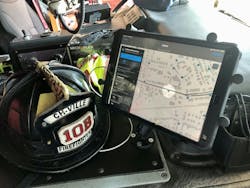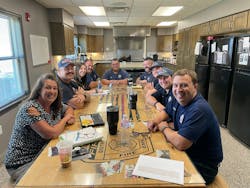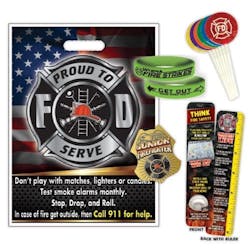Innovations in CRR: Data-Centered, Web-Based Forms
Community risk reduction (CRR) isn’t glamorous and doesn’t make the nightly news with flashing lights and shiny fire trucks. However, it is a game-changer in the fire service. Interestingly, we accept that there’s an opportunity to create lasting community outcomes, but CRR doesn’t fit easily into our reactive environment. CRR has an abstract starting point and, in most cases, an unmeasurable endpoint. In short, CRR is difficult.
CRR also is challenging, because it involves (or should involve) a level of data collection and analytics that’s unfamiliar to many of us. We were taught that CRR is based initially on risk assessments that focus activities on target populations or communities. What about the CRR things that fall outside of a typical risk assessment but happen throughout the day, such as broken sprinkler heads, frequent 9-1-1 callers and impromptu public engagements? If we think about it, CRR isn’t just about focusing attention on the community risk priorities but also securing the right resources to achieve outcomes most effectively for all of those who we serve.
Fire watches evolved
When I was a city fire official, one of our fire marshals and I were updating the paper process that our department used to establish fire watches. For those who don’t know the “joy,” fire watches are an essential process that initiates when a fire protection system in an occupied commercial building is inoperable. To prevent a fire department-mandated evacuation, business operators can opt to establish a fire watch.
Our process was cumbersome and intensively hands-on, required a lot of unwanted overtime (the wake-up-and-drive-to-the-city-at-3 a.m. kind of overtime) and didn’t collect any actionable data in its pen-and-paper process. We both believed that there had to be a better way, so we began to explore the existing resources that were available to our department, because, as is the case with so many local governments, we didn’t have any money. We took the paper process and transferred it, nearly word for word, to ArcGIS Survey123. Survey123 is a highly functional forms application, much like Microsoft Forms and SurveyMonkey, but it’s more customizable and data-centered. Doing this allowed us to gather and retain a wealth of information during the fire watch process.
The new web-based form was slick and looked cool; however, what we created was arguably no better than the legacy paper process. More importantly, the new process wasn’t any easier for firefighters.
Before throwing in the towel and heading back to the copy machine, we forged on. CRR forces us to learn through experience and continually adapt, to look inward and find resources that don’t prompt purchase orders. So, we took our slick web form to the next level. (Here’s where I realized that I lost touch with why I initially joined the fire service.) We started to achieve some significant outcomes without spending a dime.
We realized that Survey123, as is the case with numerous other applications, can trigger process automation through things called webhooks. In short, we discovered that submitting a fire watch form using an iPad can set off a string of events (or flows) that interact with email, text messages and Microsoft Teams. Honestly, it can do so much more, but that’s for another article.
‘Magic’
With the paper-process-turned-Survey123 web form, we deployed the tool into our field operations. At 3 a.m., when an engine company responded to a fire alarm at a hotel and found a fire protection system out-of-service, the company officer grabbed the iPad. Following the directions on the web form, the hotel’s night manager answered all of the questions, acknowledged all items and signed the form with a finger. Upon receiving the device back, the company officer knew everything was complete through a bit of built-in conditional formatting, much like an electronic incident report. The company officer filled in a few remaining fields and, when finished, hit the submit button.
Here is where the magic happens. Using a webhook with automation tools (we used Power Automate, which was standard with our local government Microsoft 365 accounts), the submission of the web form prompted an email to the hotel night manager (using the email address that was provided on the iPad) that included all of the forms and guidelines for a fire watch, a Teams notification to the on-duty shift commander, notification to the E9-1-1 center and a log entry to a dashboard for fire marshal follow-up the next day. There even was a follow-up to the hotel manager at lunchtime on the next business day.
We were excited about how well it worked and realized how a similar process could be used in other risk-reduction areas. We created another web form (with webhook-prompted automation) to eliminate the antiquated process for firefighters to report frequent 9-1-1 callers. To take it a step further, we worked with our local social services and expanded the automation to integrate adult protective services reporting.
QR codes
Our operations began to expand, and before long, we had four different processes: fire watches, reporting habitual 9-1-1 users, tracking public outreach and critical-incident notifications. Yet, as our process count grew, we inadvertently created inefficiencies. QR codes and bumper stickers, however, provided a surprising solution.
We printed bumper stickers (the least expensive and most durable option) that had the QR codes and affixed the stickers to the inside of the company officer’s door on the rig. The officer then had no problems launching the correct web form, collecting actionable data and making notifications. Although not CRR in the “traditional” concept, these developments in our department took CRR to a whole new level. We now instantly pulled in risk-reduction partners, such as social services and mental health (in conjunction with frequent 9-1-1 callers), the E9-1-1 center (fire watch) and the peer support team (critical-incident notifications). We collected data on impromptu public interactions and developed dashboard views for better situational awareness. We followed up with citizens and provided accurate information.
CRR is all about identifying the risks, securing the right resources and analyzing the data to measure performance. What we did in our city contributed to CRR and was a significant step forward.
Think differently
All of us can make terrific things happen in our community if we take a few minutes and learn something new. The no-cost opportunities to improve community outcomes by applying technology are expanding continually. Using web forms, such as ArcGIS Survey123, and automation can improve field data collection, reduce operational headaches and improve administrative support.
In the end, we can find little efficiencies by thinking differently and working together. Just remember, not everything needs to affect your budget. Sometimes, you must use what you have.
PRODUCT SPOTLIGHT
Online CRR Forum
The “CRR Kitchen Table” is a monthly, online forum where fire service and safety professionals share their experiences with data-driven community risk reduction (CRR). Each interactive session highlights a local initiative, discussing strategies for getting started, progress monitoring and overcoming challenges. Email Karen Berard-Reed at [email protected] to attend.
Home Fire Sprinklers
Fire Prevention in the Community
Be a part of your town’s “Night Out” event with the Community Night Out Pack. Complete with 500 products, it’s a great way to stretch a thin fire prevention budget while still affecting your community and spreading the message of fire safety all year.
About the Author

Joe Powers
Joe Powers is a 28-year fire service veteran, holds a master's degree in public administration and is the managing director of Emergency Services Consulting International, which is the consulting firm of the International Association of Fire Chiefs (IAFC). He has worked closely with the Center for Public Safety Excellence, served as an IAFC board member for the Fire & Life Safety Section and is a past steering committee member for Vision 20/20. Powers, who believes that the industry's value extends beyond primary emergency response to building a more resilient community through risk assessment, partnerships and matching resources to need, frequently speaks at conferences on CRR strategic planning and fire service data.




